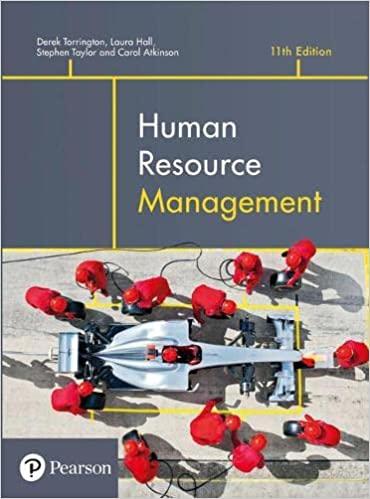Kaufman (2013) reports a study of the Delta Air Lines employee involvement programme, which forms part of
Question:
Kaufman (2013) reports a study of the Delta Air Lines employee involvement programme, which forms part of the organisation’s attempt to maintain a high-commitment model of employment relations. In essence, Delta sees employee involvement as a way to improve efficiency and communication and to ensure that employees feel valued and well treated.
Providing voice mechanisms is also seen as a way to reduce the demand for external representation and underpins Delta’s partnership and non-union approach. Kaufman argues that the breadth, depth and formal structure of Delta’s employee involvement mechanisms make it one of the leading non-union employee involvement companies in the USA, particularly in respect of representative councils and forums.
Delta adopts a three-stage formal employee involvement structure:
1. An organisation-wide consultative committee with five employee representatives, one from each of the major divisions.
2. Four employee involvement groups at divisional level, including: flight attendants, customer service and cargo, technical operations and reservation sales/city ticket offices. The first three of these have a two-layered structure with elected representatives at both city/base forums and system-wide forums.
3. In excess of 100 project teams which operate either across divisions or at particular sites, depending on the nature of the project.
These structures are supplemented by six organisation-wide groups to support employee diversity and, in some divisions, by a peer-review dispute resolution system. There are also a substantial number of other employee involvement activities including monthly CEO breakfasts and phone-ins where employees can ask questions of and provide feedback to senior executives.
Employee involvement mechanisms were central to Delta’s merger with Northwest Airlines (NA). Twenty-seven project teams were established to address a whole range of matters, from strategic to low-level operational issues. These project teams comprised equal numbers of Delta and NA employees to foster a spirit of shared identity. Employee involvement was also central to integrating NA employees, from a unionised adversarial culture, into Delta’s highcommitment culture. Promises made at the time of the merger, for example that pay rises would be made, were kept, NA employees were included in the councils and forums described above, and ‘get acquainted’ meetings were held. Former NA employees expressed surprise that the forums were able to achieve positive outcomes and offer protection to employees. Indeed, employee involvement is widely seen as a means to build a successful company and ensure that benefits accrue to all stakeholders, rather than a form of ‘anti-union’ mechanism. Kaufman attributes this to three things:
1. Some forum representatives are also union supporters and will not tolerate anti-union activity.
2. There is recognition that both organisation and employee representatives lose credibility if they tolerate or support anti-unionism.
3. Delta does not want to create an environment where union representation might seem desirable or take action that might prompt calls for union representation.
It is noteworthy that when, post-merger, there were calls for union recognition, the unions lost all the elections by a relatively wide margin.
Kaufman summarises Delta’s approach to employee involvement as being quite successful, although he notes that it was introduced in a piecemeal fashion across the 1990s without any overarching HR vision. Nevertheless, employee involvement has supported a transition from employee commitment based upon a paternalistic employment relationship to commitment premised upon a mutual gains scenario in which management and workers cooperate to drive high performance that benefits both parties.
Questions
1. Using Marchington and Cox’s ‘escalator’ model, how would you categorise Delta’s approach to employee voice?
2. What other mechanisms could Delta use to offer employee voice?
3. To what extent do you agree that Delta’s approach to employee voice makes union representation unnecessary?
Step by Step Answer:

Human Resource Management
ISBN: 9781292261645
11th Edition
Authors: Derek Torrington, Laura Hall, Stephen Taylor, Carol Atkinson





